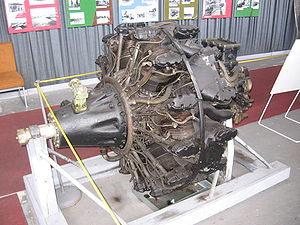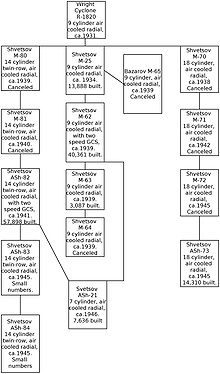- Shvetsov ASh-82
-
ASh-82 Preserved Shvetsov ASh-82 at the Prague Aviation Museum, Kbely Type Radial engine Manufacturer Shvetsov & Evich, OKB-19 in Perm' First run 1940 Number built 70,000 (57.898 of Ash-82, 82F & 82FN in wartime) Developed from Shvetsov M-62 The Shvetsov ASh-82 (M-82) is a 14-cylinder, two-row, air-cooled radial aircraft engine developed from the Shvetsov M-62, itself a development from M-25 a licensed version of the Wright R-1820 Cyclone.
Contents
Design and development
Arkadiy Shvetsov developed the Wright Cyclone design, reducing the stroke, dimensions and weight. This allowed the engine to be used in light aircraft, where a Twin Cyclone could not be installed[1]. It entered production in 1940 and saw service in a number of Soviet aircraft. It powered the Tupolev Tu-2 and Pe-8 bombers and the inline engine-powered LaGG-3 was adapted for the ASh-82, additionally the famous Lavochkin La-5, Lavochkin La-7 fighters, and the Ilyushin Il-14 airliner were created around the engine. Over 70,000 ASh-82s were built.
Variants
- ASh-82-111 (M-82-111) - First mass-produced ASh-82, with carburettors and one two-speed supercharger. This engine had lubrication and carburettor problems in extreme cold conditions.
- ASh-82-112 (M-82-112) - Improved M-82-111 with longer Time between overhaul (TBO) and better reliability. Redesigned carburettors, oil pumps, gear, turbocharger and reinforced pushrods. This engine worked better in the harsh Russian winter.
- ASh-82F (M-82F) - Identical to ASh-82 except for longer Time between overhaul and improved cooling and lubrication which allowed unlimited operation at takeoff power.
- ASh-82FN (M-82FN) - ASh-82F with gasoline direct injection, power output increased to 1,230 kW (1,650 hp) for takeoff with only a 30 kg (65 lb) increase in engine weight, used by Pe-8 long-range bombers and Lavochkin La-7 fighters.
- ASh-82FNU (M-82FNU) - Improved M-82FN with more boost pressure and RPM, power output increased to 1,380 kW (1,850 hp). After all the improvements, the ASh-82FN and ASh-82FNU were two of the most sturdy radial engines of the war[2].
- ASh-21 (M-21) - Single-row 7-cylinder version of ASh-82 for Yakovlev Yak-11 trainer, entered production in 1946.
- ASh-82T (M-82T) - New version of the Ash-82FNU developed in the early fifties for civilian aircraft. Previous version twin turbochargers were replaced with a large single-speed compressor attached to an after-cooler (the critical altitude was 2,000 m, 6,561 ft). Optionally, the engine was provided with a two-speed turbocharger (with a critical altitude of 4,000 m, 13,123 ft, the robustness of the engine allowed to take off in second speed). New alloys were used and some components were upgraded, thus reducing maintenance operations. Special care was put into reducing the engine noise level and an optional exhaust double silencer was available. The engine had a new fuel injection system and improved specific fuel consumption (a 16% reduction at cruise speed compared to 82FNU). A four-blade high efficiency propeller, the Typ AB-50m, was developed for the 82T version. This radial engine had an excellent reputation for its reliability and simple maintenance; there are still aircraft in service with this engine thanks to the inexpensive spare parts and the possibility to use automotive gasoline [3]. The power was 1,900 hp (1,417 kW) at 2,600 RPM for takeoff, with 95 or 100 octane Avgas. Maximum continuous power was 1,630 hp (1,215 kW). Lower octane fuel, 90 octane Avgas or equivalent automotive gas, was allowed with minor modifications and turbocharger Manifold Pressure restrictions that limited the power to 1,700 hp (1,268 kW).[4]
- ASh-82V (M-82V) - Helicopter version of the ASh-82T developed in 1952, with axial-flow fan mounted in the fuselage's front. The engine was connected to a R-5 two-stage planetary primary gearbox with the help of a shaft (which was between the pilots seats). This engine was used in the Mi-4 and Jak-24 helicopters[5]
- ASh-2TK and ASh-2K (ASh-4K) – Four-row versions of the Ash-82, developed in the late '40s. The engine concept was similar to the Pratt & Whitney R-4360. The Shvetsov design bureau took into consideration all available information about the R-4360 and developed an engine with less maintenance operations, longer time between overhaul, direct fuel injection and a simpler supercharging system. The ASh-2TK had a two-stage two-speed supercharging system with intercooler (similar to the ASh-73) that compromised a long engine's TBO. Finally the ASh-2TK was discarded and a new version was developed, the ASh-4K, with an experimental variable-speed turbocharger and after-cooler, which allowed a cruising altitude of 11,000 m (36,089 ft). The engine had 82.4 liters (5,030 cu in) and 4,000 HP (2,985 kW) at 2,600 RPM (dry). The Ash-2K (ASh-4K) version had 4,700 HP (3.507 kW) wet, with a water-methanol system. For political reasons, these engines were prematurely installed in Tupolev Tu-4LL testbeds at the end of 1950, when the prototypes' initial tests had barely begun. The engines had mature and overheating problems, and required a long testing period. Most of the flaws were fixed in the mid-fifties, but the production was cancelled: in those days, the priority for the Soviet Air Force were turboprop and jet engines[6].
- Dongan HS7 A Chinese license built copy of the ASh-82V, and the chosen engine for powering modern 21st century reproductions of the Focke-Wulf Fw 190A built in Germany.
Applications
- Amtorg KM-2 (Improved PBY Catalina, built under Consolidated license)
- Gudkov Gu-82 (Prototype)
- Ilyushin Il-2 (prototype)
- Ilyushin Il-12
- Ilyushin Il-14
- Kocherigin OPB-5 (prototype)
- Lavochkin La-5
- Lavochkin La-7
- Lavochkin La-9
- Lavochkin La-11
- MiG-5
- MiG-9 I-210 (1941 Prototype)
- Mikoyan-Gurevich I-211 prototype
- Mil Mi-4
- Petlyakov Pe-2
- Petlyakov Pe-8
- Polikarpov I-185 (Prototype)
- Sukhoi Su-2
- Sukhoi Su-7
- Sukhoi Su-12
- Tupolev Tu-2
- Yakovlev Yak-24
Specifications (ASh-82)
General characteristics
- Type: 14-cylinder two-row radial engine
- Bore: 155.5 mm (6.122 in)
- Stroke: 155.0 mm (6.102 in)
- Displacement: 41.2107 L (2,515.3 cu in)
- Length: 2.01 m (6ft 7.1 in)
- Diameter: 1.26 m (49.6 in)
- Dry weight: M-82-112 model: 860 kg (1,894 Ib), M-82FN model: 890 kg (1,962 Ib), M-82FNU model: 900 kg (1,984 lb), M-82T model: 1,020 kg (2,246 lb)
Components
- Valvetrain: Pushrod, two valves per cylinder with sodium-cooled exhaust valve.
- Supercharger: Single-stage, One TK-2 two-speed centrifugal type turbocharger on early production. Two TK-3 two-speed exhaust gas-driven forced-induction compressor on FN and FNU models. For the M-82T: Single-speed centrifugal turbocharger with after-cooler. The gear ratio was 7.27:1. Critical altitude: 2,000 m (6,561 ft). Optionally, the M-82T had a two speed turbocharger with after-cooler; the second speed gear ratio was 10,2:1. Critical altitude: 4,000 m (13,123 ft). Manifold pressure limit: 1.64 Atm (49.2") for takeoff and 1.34 Atm (40.15") at second speed.
- Fuel system: Carburettors (early production), direct fuel injection with automatic mixture control. Petrol pump: BNK-10KT.
- Fuel type: 90 octane (minimum grade allowed), 92, 95 or 100 octane
- Oil system: Two pumps: geared rotation pump MSH-6SV (rear) and swarm pump PMN-T (front). Normal oil temp: 40 to 90ºC. Limit temp: 115ºC. Minimum oil pressure at low gas: 3 kg/cm2 (42.7 PSI). Minimum oil pressure at cruise: 4.5 kg/cm2 (front pump), 5.5 kg/cm2 (rear pump) (64 PSI front and 78.2 PSI rear)
- Cooling system: Air-cooled. Minimum permissible cylinders temp for operation: 120ºC. Maximum permissible cylinders temp: 250ºC. Maximum permissible at cruise: 225ºC. Normal cylinders temp at cruise: 160 to 180ºC
- Reduction gear: 11:16 (prototypes & M-82-111), 9:16 (M-82-112 and later models)
Performance
- Power output:
- M-82-111 with carburettors:
- 1,570 hp (1,170 kW) at 2,400 RPM for take-off (Dry), boost rated at 1.55 Atm (46.3")
- 1,540 hp (1,148 kW) at 2,400 RPM at 6,656 ft (2,050 m)
- 1,330 hp (992 kW) at 2,400 RPM at 17,716 ft (5,400 m), boost rated at 1.29 Atm (38.6")
- 820 hp (612 kW) at 2,400 RPM at 27,887 ft (8,500 m)
- M-82FN with direct fuel injection:
- 1,650 hp (1,230 kW) at 2,400 RPM for take-off (Dry), boost rated at 1.55 Atm (46.3")
- 1,430 hp (1,067 kW) at 2,400 RPM at 16,404 ft (5,000 m)
- 800 hp (597 kW) at 2,400 RPM at 32,808 ft (10,000 m)
- M-82FNU:
- 1,850 hp (1,380 kW) at 2,500 RPM for take-off (Dry), boost rated at 1.60 Atm (47.88")
- 1,650 hp (1,230 kW) at 2,400 RPM at 5,413 ft (1,650 m), boost rated at 1.36 Atm (40.7")
- 1,450 hp (1,082 kW) at 2,400 RPM at 15,156 ft (4,650 m), boost rated at 1.36 Atm (40.7")
- 810 hp (604 kW) at 2,400 RPM at 34,448 ft (10,500 m)
- M-82T with two speed turbocharger:
- 1,900 hp (1,416 kW) at 2,600 RPM for take-off, boost rated at 1.64 Atm (49.2")
- 1,630 hp (1,215 kW) at 2,400 RPM at 6,561 ft (2,000 m), boost rated at 1.34 Atm (40.1")
- 1,530 hp (1,082 kW) at 2,400 RPM at 13,123 ft (4,000 m), boost rated at 1.34 Atm (40.1")
- 721 hp (537 kW) at 2,400 RPM at 31,167 ft (9,500 m)
- Specific power: M-82FN: 29.84 kW/L (0.655 hp/in³), M-82FNU: 33.48 kW/L (0.735 hp/in³)
- Compression ratio: 7.05:1 (6.90:1 for M-82T)
- Specific fuel consumption:
- M-82FN: 355 g/hp•h (0.78 Ib/hp•hr) for take-off, 320 g/hp•hr (0.70 Ib/hp•hr) at nominal power
- M-82FNU: 360 g/hp•h (0.79 Ib/hp•hr) for take-off, 325 g/hp•hr (0.71 Ib/hp•hr) at nominal power
- M-82T: 350 to 325 g/hp•h (0.76 to 0.71 Ib/hp•hr) for take-off, 260 to 280 g/hp•hr (0.568 to 0.611 Ib/hp•hr) at cruise power
- Power-to-weight ratio: 1.46 kW/kg (0.89 hp/lb)
See also
- Comparable engines
- BMW 801
- Bristol Hercules
- Pratt & Whitney R-1830
- Wright R-2600
- Fiat A.74
- Gnome-Rhône 14N
- Mitsubishi Kinsei
- Nakajima Sakae
- Related lists
References
Notes
- ^ Witold Liss (1967). The Lavochkin La 5 & 7, number 149. Profile publications Ltd., P.O. Box, 1a North Street, Leatherhead, Surrey, UK. pp. p. 3
- ^ Very few engines were able to operate at take-off power without time restrictions.
- ^ Samolot transportowy Il-14, Benedykt Kempski. Wydawnictwo Ministerstwo Obrony Narodowej
- ^ ORDER. Chief of Civil Air Fleet. The Council of Ministers of the USSR. Number 508. August 5, 1963, Moscow.On enactment of the "Guide to Flight operation and piloting of the IL-14 with two engines AL-82T "
- ^ http://www.avid.ru/eng/pr/news/514/
- ^ Yefim Gordon, Vladimir Rigmant (2002). Tupolev Tu-4, Soviet Superfortress (Red Star, Vol.7). Midland Publishing ISBN 1-85780-142-3. pp. 54–59.
- ^ Liss, Witold (1967). The Lavochkin La 5 & 7, number 149. Profile publications Ltd., P.O. Box, 1a North Street, Leatherhead, Surrey, UK. pp. 3, 5–6, 8–9.
- ^ ORDER. Chief of Civil Air Fleet. The Council of Ministers of the USSR. Number 508. August 5, 1963, Moscow.On enactment of the "Guide to Flight operation and piloting of the IL-14 with two engines AL-82T "
External links
Shvetsov aircraft engines Radial engines Lists relating to aviation General Aircraft (manufacturers) · Aircraft engines (manufacturers) · Airlines (defunct) · Airports · Civil authorities · Museums · Registration prefixes · Rotorcraft (manufacturers) · TimelineMilitary Accidents/incidents Records Categories:- Radial engines
- Shvetsov aircraft engines
- Aircraft piston engines 1940-1949
Wikimedia Foundation. 2010.



